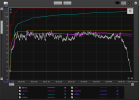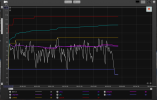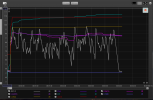"What you really need is a power amp. That Denon has soft power. If you pump 200 watts into those things they'll really come alive" is what my local dealer told me today.
The speakers are Monitor Audio Silver 500 driven by a Denon Avr rated at 105 watts.
Considering I only need about 25 watts to listen at around 95db how can having an extra 100 watts over what I already have make any difference?
I did not read the entire thread so apologies if this has already been covered. AND I am not an amplifier guy so I welcome correction from anyone who is, anyway the following will not be strictly accurate but I think the trends described are in the ballpark.
When it comes to the amplification section of AVRs, the fine print matters. What exactly does the Denon's spec sheet say? The following will be a hypotherical "worst case scenario" - I am NOT accusing Denon of being this optimistic with their specs! But this will be something that imo is worth being aware of.
IF the spec sheet of an over-optimistically-rated AVR says something like "100 watts per channel at 1 kHz with one channel driven", and then they multiply that 100 watts by the number of channels, say six, they might claim that it's a "600 watt" receiver. If the limiting factor is the power supply, which is quite likely, then the actual output with all six channels driven equally might only be 100/6 = 16.7 watts. This is an extreme example, for illustration purposes.
If you are only using the front three channels, we'd be looking at 33.3 watts per channel, assuming our hypothetical wimpy power supply only delivers enough power for the amplifier modules to put out a combined total of 100 watts.
But it gets worse.
That 33.3 watts/channel with only the front three channels driven is with a 1 kHz sine wave. Real program material is much more broadband,. and amplifiers generally deliver far less wattage broadband than they do into a sine wave. Like maybe ballpark 20% of their sinewave power output. So now our 33.3 watts sine-wave is down to about 7 watts broad-band.
Something like the above might be why your dealer used the term "soft power".
(The substantial difference between an amplifier's sine-wave power output and broadband power output was described to me by the late, great Henry Wolcott, who designed an outstanding tube amp. It was based on a tube amp that he designed for powering a bank of computer hard drives for a large government contractor; unfortunately I don't recall why tubes were preferred for that application. Henry's day job also included designing and building unique test equipment for Defense Department contracts. So if Northrop Grumman won the contract to build the new radar for the F-35, Northrop's claimed performance would have to be vertified by testing. And if sufficiently capable test equipment did not yet exist, Henry's company Metrology Instruments would be the one to design and build it. I think that actually happened, though he never said so to me in so many words.)




 www.audiosciencereview.com
www.audiosciencereview.com
